9.5: Radiation from an Electrically-Short Dipole
( \newcommand{\kernel}{\mathrm{null}\,}\)
The simplest distribution of radiating current that is encountered in common practice is the electrically-short dipole (ESD). This current distribution is shown in Figure 9.5.1.
 Figure 9.5.1: Current distribution of the electrically-short dipole (ESD). ( CC BY-SA 4.0; C. Wang)
Figure 9.5.1: Current distribution of the electrically-short dipole (ESD). ( CC BY-SA 4.0; C. Wang)
The two characteristics that define the ESD are (1) the current is aligned along a straight line, and (2) the length L of the line is much less than one-half of a wavelength; i.e., L≪λ/2. The latter characteristic is what we mean by “electrically-short.”1
The current distribution of an ESD is approximately triangular in magnitude, and approximately constant in phase. How do we know this? First, note that distributions of current cannot change in a complex or rapid way over such distances which are much less than a wavelength. If this is not immediately apparent, recall the behavior of transmission lines: The current standing wave on a transmission line exhibits a period of λ/2, regardless the source or termination. For the ESD, L≪λ/2 and so we expect an even simpler variation. Also, we know that the current at the ends of the dipole must be zero, simply because the dipole ends there. These considerations imply that the current distribution of the ESD is well-approximated as triangular in magnitude.2 Expressed mathematically:
˜I(z)≈I0(1−2L|z|)
where I0 (SI base units of A) is a complex-valued constant indicating the maximum current magnitude and phase.
There are two approaches that we might consider in order to find the electric field radiated by an ESD. The first approach is to calculate the magnetic vector potential ˜A by integration over the current distribution, calculate ˜H=(1/μ)∇טA, and finally calculate ˜E from ˜H using Ampere’s law. We shall employ a simpler approach, shown in Figure 9.5.2.
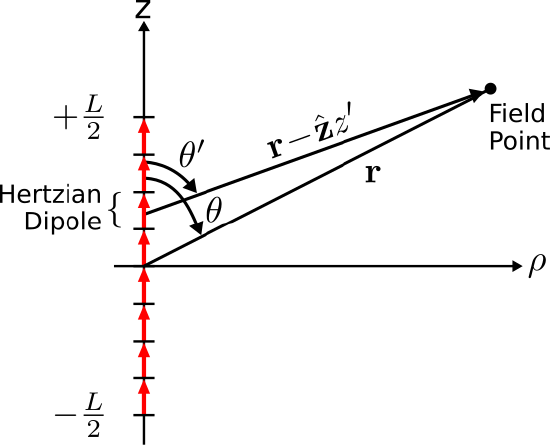 Figure 9.5.2: Current distribution of the electricallyshort dipole (ESD) approximated as a large number of Hertzian dipoles. ( CC BY-SA 4.0; C. Wang)
Figure 9.5.2: Current distribution of the electricallyshort dipole (ESD) approximated as a large number of Hertzian dipoles. ( CC BY-SA 4.0; C. Wang)
Imagine the ESD as a collection of many shorter segments of current that radiate independently. The total field is then the sum of these short segments. Because these segments are very short relative to the length of the dipole as well as being short relative to a wavelength, we may approximate the current over each segment as approximately constant. In other words, we may interpret each of these segments as being, to a good approximation, a Hertzian dipole.
The advantage of this approach is that we already have a solution for each of the segments. In Section 9.4, it is shown that a ˆz-directed Hertzian dipole at the origin radiates the electric field
˜E(r)≈ˆθjη˜I⋅βΔl4π (sinθ)e−jβrr
where ˜I and Δl may be interpreted as the current and length of the dipole, respectively. In this expression, η is the wave impedance of medium in which the dipole radiates (e.g., ≈377 Ω for free space), and we have presumed lossless media such that the attenuation constant α≈0 and the phase propagation constant β=2π/λ. This expression also assumes field points far from the dipole; specifically, distances r that are much greater than λ. Repurposing this expression for the present problem, the segment at the origin radiates the electric field:
˜E(r;z′=0)≈ˆθjηI0⋅βΔl4π (sinθ)e−jβrr
where the notation z′=0 indicates the Hertzian dipole is located at the origin. Letting the length Δl of this segment shrink to differential length dz′, we may describe the contribution of this segment to the field radiated by the ESD as follows:
d˜E(r;z′=0)≈ˆθjηI0⋅βdz′4π (sinθ)e−jβrr
Using this approach, the electric field radiated by any segment can be written:
d˜E(r;z′)≈ˆθ′jηβ˜I(z′)4π(sinθ′)e−jβ|r−ˆzz′||r−ˆzz′| dz′
Note that θ is replaced by θ′ since the ray r−ˆzz′ forms a different angle (i.e., θ′) with respect to ˆz. Similarly, ˆθ is replaced by ˆθ′, since it also varies with z′. The electric field radiated by the ESD is obtained by integration over these contributions:
˜E(r)≈∫+L/2−L/2d˜E(ˆr;z′)
yielding:
˜E(r)≈jηβ4π∫+L/2−L/2ˆθ′˜I(z′) (sinθ′)e−jβ|r−ˆzz′||r−ˆzz′|dz′
Given some of the assumptions we have already made, this expression can be further simplified. For example, note that θ′≈θ since L≪r. For the same reason, ˆθ′≈ˆθ. Since these variables are approximately constant over the length of the dipole, we may move them outside the integral, yielding:
˜E(r)≈ˆθjηβ4π (sinθ)∫+L/2−L/2˜I(z′)e−jβ|r−ˆzz′||r−ˆzz′|dz′
It is also possible to simplify the expression |r−ˆzz′|. Consider Figure 9.5.3.
 Figure 9.5.3: Parallel ray approximation for an ESD. ( CC BY-SA 4.0; C. Wang)
Figure 9.5.3: Parallel ray approximation for an ESD. ( CC BY-SA 4.0; C. Wang)
Since we have already assumed that r≫L (i.e., the distance to field points is much greater than the length of the dipole), the vector r is approximately parallel to the vector r−ˆzz′. Subsequently, it must be true that
|r−ˆzz′|≈r−ˆr⋅ˆzz′
Note that the magnitude of r−ˆr⋅ˆzz′ must be approximately equal to r, since r≫L. So, insofar as |r−ˆzz′| determines the magnitude of ˜E(r), we may use the approximation:
|r−ˆzz′|≈r (magnitude)
Insofar as |r−ˆzz′| determines phase, we have to be a bit more careful. The part of the integrand of Equation ??? that exhibits varying phase is e−jβ|r−ˆzz′|. Using Equation ???, we find
e−jβ|r−ˆzz′|≈e−jβre+jβˆr⋅ˆzz′
The worst case in terms of phase variation within the integral is for field points along the z axis. For these points, ˆr⋅ˆz=±1 and subsequently |r−ˆzz′| varies from z−L/2 to z+L/2 where z is the location of the field point. However, since L≪λ (i.e., because the dipole is electrically short), this difference in lengths is much less than λ/2. Therefore, the phase βˆr⋅ˆzz′ varies by much less than π radians, and subsequently e−jβˆr⋅ˆzz′≈1. We conclude that under these conditions,
e−jβ|r−ˆzz′|≈e−jβr (phase)
Applying these simplifications for magnitude and phase to Equation ???, we obtain:
˜E(r)≈ˆθjηβ4π(sinθ)e−jβrr ∫+L/2−L/2˜I(z′)dz′
The integral in this equation is very easy to evaluate; in fact, from inspection (Figure 9.5.1), we determine it is equal to I0L/2. Finally, we obtain:
˜E(r)≈ˆθjηI0⋅βL8π (sinθ) e−jβrr
Summarizing:
The electric field intensity radiated by an ESD located at the origin and aligned along the z axis is given by Equation ???. This expression is valid for r≫λ.
It is worth noting that the variation in magnitude, phase, and polarization of the ESD with field point location is identical to that of a single Hertzian dipole having current moment ˆzI0L/2 (Section 9.4). However, the magnitude of the field radiated by the ESD is exactly one-half that of the Hertzian dipole. Why one-half? Simply because the integral over the triangular current distribution assumed for the ESD is one-half the integral over the uniform current distribution that defines the Hertzian dipole. This similarly sometimes causes confusion between Hertzian dipoles and ESDs. Remember that ESDs are physically realizable, whereas Hertzian dipoles are not.
It is common to eliminate the factor of β in the magnitude using the relationship β=2π/λ, yielding:
˜E(r)≈ˆθjηI04Lλ (sinθ) e−jβrr
At field points r≫λ, the wave appears to be locally planar. Therefore, we are justified using the plane wave relationship ˜H=1ηˆrטE to calculate ˜H. The result is:
˜H(r)≈ˆϕjI04Lλ (sinθ) e−jβrr
Finally, let us consider the spatial characteristics of the radiated field. Figures 9.5.4 and 9.5.5 show the result in a plane of constant ϕ. Figures 9.5.6 and 9.5.7 show the result in the z=0 plane. Note that the orientations of the electric and magnetic field vectors indicate a Poynting vector ˜EטH that is always directed radially outward from the location of the dipole. This confirms that power flow is always directed radially outward from the dipole. Due to the symmetry of the problem, Figures 9.5.4 – 9.5.7 provide a complete characterization of the relative magnitudes and orientations of the radiated fields.
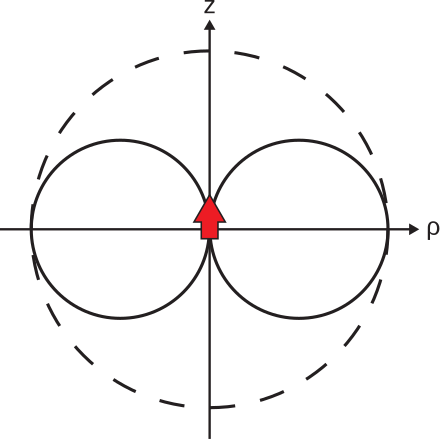 Figure 9.5.4: Magnitude of the radiated field in any plane of constant ϕ. ( CC BY-SA 4.0; S. Lally)
Figure 9.5.4: Magnitude of the radiated field in any plane of constant ϕ. ( CC BY-SA 4.0; S. Lally)
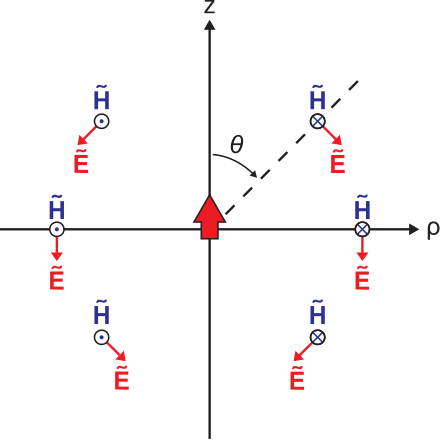 Figure 9.5.5: Orientation of the electric and magnetic fields in any plane of constant ϕ. ( CC BY-SA 4.0; S. Lally)
Figure 9.5.5: Orientation of the electric and magnetic fields in any plane of constant ϕ. ( CC BY-SA 4.0; S. Lally)
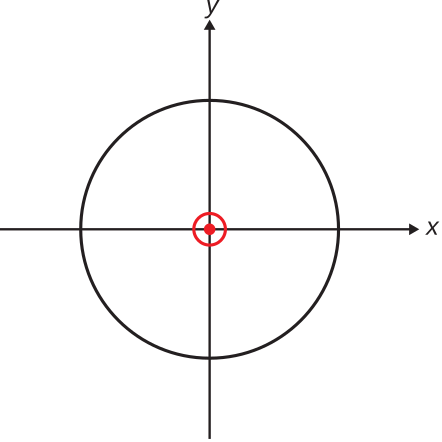 Figure 9.5.6: Magnitude of the radiated field in any plane of constant z. ( CC BY-SA 4.0; S. Lally)
Figure 9.5.6: Magnitude of the radiated field in any plane of constant z. ( CC BY-SA 4.0; S. Lally)
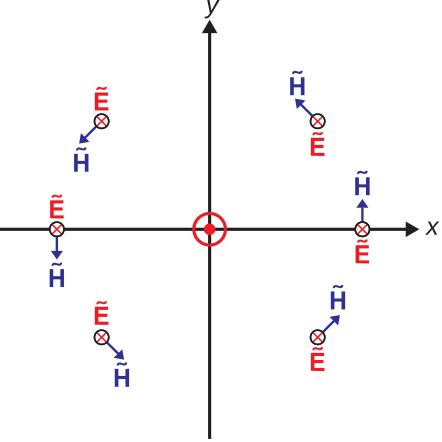 Figure 9.5.7: Orientation of the electric and magnetic fields in the z=0 plane. ( CC BY-SA 4.0; S. Lally)
Figure 9.5.7: Orientation of the electric and magnetic fields in the z=0 plane. ( CC BY-SA 4.0; S. Lally)
- A potential source of confusion is that the Hertzian dipole is also a “dipole” which is “electrically-short.” The distinction is that the current comprising a Hertzian dipole is constant over its length. This condition is rarely and only approximately seen in practice, whereas the triangular magnitude distribution is a relatively good approximation to a broad class of commonly-encountered electrically-short wire antennas. Thus, the term “electrically-short dipole,” as used in this book, refers to the triangular distribution unless noted otherwise.↩
- A more rigorous analysis leading to the same conclusion is possible, but is beyond the scope of this book.↩


